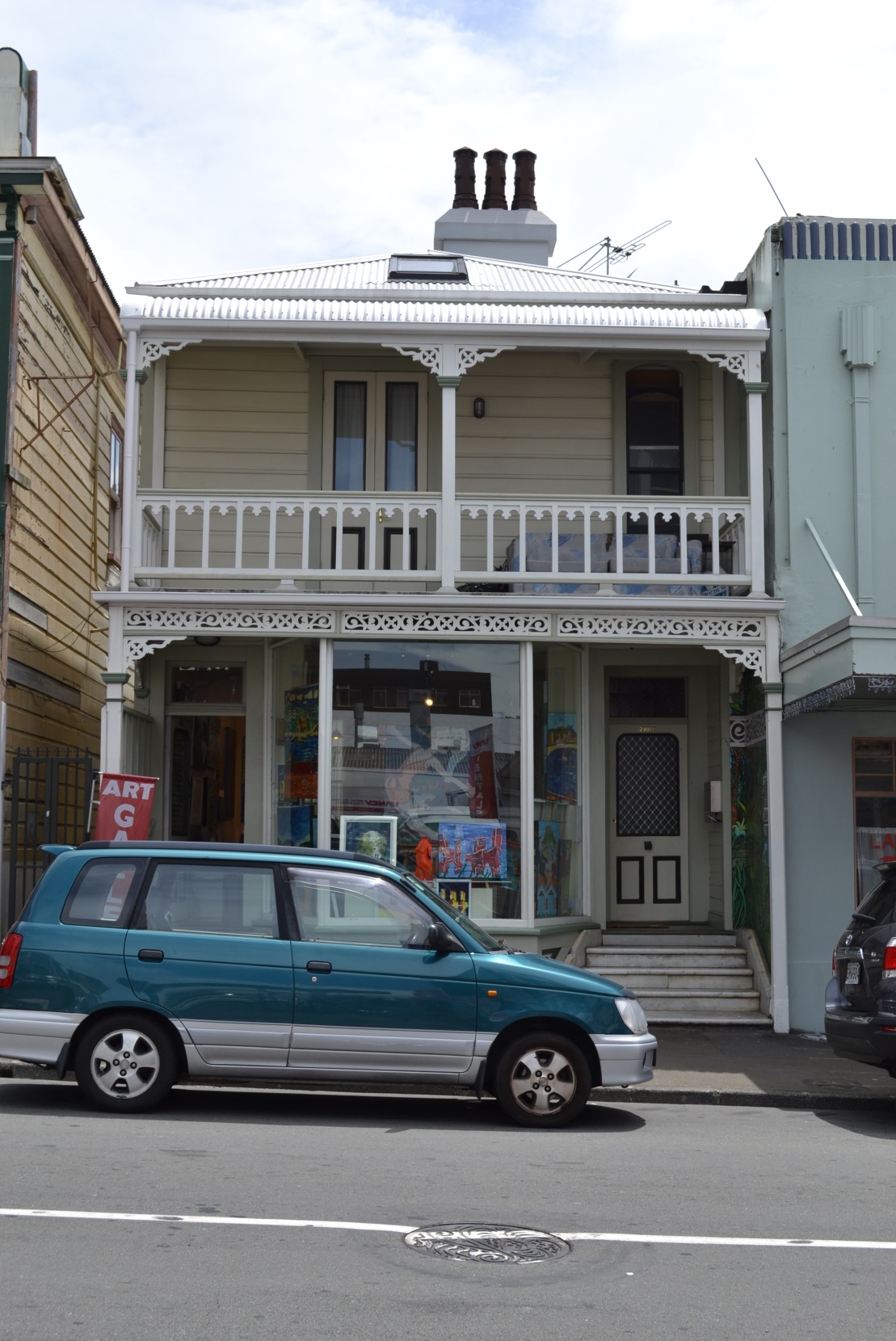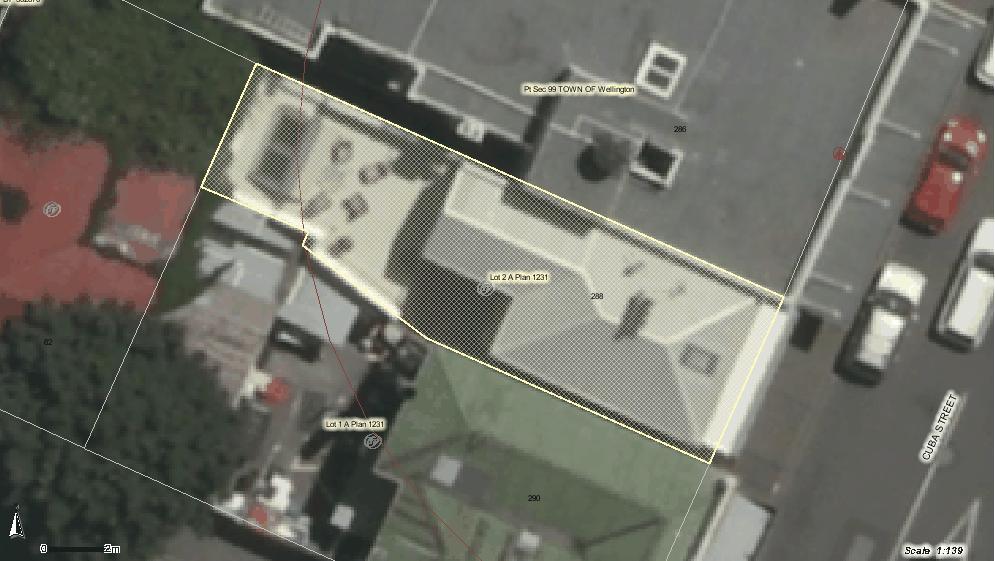Shop / Dwelling
Kiwi Art House
-
Constructed
1901
-
Heritage Area
-
Architect(s)
-
Builder(s)
Unknown
-
288 Cuba Street has historical significance as a good representative example of an Edwardian shop/dwelling that was designed in the NZ timber Italianate tradition. The building is notable for its pleasant, and well-articulated, street façade that features a two-storey verandah that is enriched with timber ornamentation. The shopfront, fenestration and chimneys are also notable as early/original features.
Further historical significance derives from one of the shop’s tenants Carmen Rupe (1936-2011), an icon in the Wellington LGBTQI+ community, who used the store for her business “Carmen’s Curios”.
This building is part of a group of two-storey timber shop/dwellings at the southern end of the Cuba Street Heritage Area.
-
Downloadable(s)
-
close
History
-
The building at 288 Cuba Street is an interesting two-storey light-commercial building, divided into two retail units at the ground floor. It is set in the Cuba Street Heritage Area and its style, use and history are typical of many of its neighbours. Cuba Street is an area of great historic and social importance to Wellington, as its formation dates back to the beginning of organised European settlement in 1840.The collection of heritage buildings on and around Cuba Street, date from about 1869 and are indicative of the development of Wellington over the past 140+ years.
Built in 1891 for William Bristow, the building started life solely as a residence. When Bristow died soon after completion, Commercial/Retail Building transferred to his widow, Nellie, whose possession indicates the ability of women to own and lease property during this period. Remarried as Nellie Allington in 1893, she leased the building to tenants before converting it into a shop with living quarters above in 1901. The property was sold to Christian Imandt in 1905, becoming a dry cleaner, and the family retained possession for 101 years before passing it on to new owners, who refurbished it from 2006-2007.
A famous tenant of Commercial/Retail Building was transgender entertainer and activist Carmen Rupe. Born Trevor David Rupe in 1936, Carmen started out as a drag performer and spent time in LGBTQI+ and sex work scenes in Wellington, Auckland, and Sydney before settling in Wellington in 1967. There she opened Carmen’s International Coffee Lounge at 86 Vivian Street with an eccentrically decorated coffee lounge downstairs and bedrooms upstairs for sex work catering to a variety of sexual preferences. The controversial lounge was hugely successful, and Carmen opened multiple new businesses around Wellington, including Carmen’s Curios in the shop at 288 Cuba Street, which she described as a ‘fascinating old house…and such an attractive building which I considered completely ideal for my type of curio outlet’. Open from ca.1972-1974, this shop was inspired by her long love of curiosities and sold antiques and second-hand goods. Carmen used her cultivated fame and notoriety in activism, vocally supporting decriminalising homosexuality, abortion and sex work, raising awareness around HIV/AIDS, and winning a landmark 1966 case where Justice McCarthy ruled that dressing as a gender not assigned at one’s birth was not a crime. Her legacy on Cuba Street continues after her 2011 death; since 2016, crossing lights have depicted her silhouette.
The building had few alterations, and perhaps little maintenance, from the time it was built until it was sold to new owners in 2007. The property was then renovated, the roof replaced, the bull-nosed first-floor terrace roof was rebuilt, as was a lean-to at the rear of the building. The renovation and restoration, including additions, was sympathetic in form, scale, materials, and proportions with the original appearance of the building, and the building makes a positive contribution to the Cuba Street streetscape.
The shop/dwelling is now in private ownership and operates as the Kiwi Art House and as a residential property.
-
Modifications
close
-
1901
-
Original construction
-
2007
-
288 Cuba Street, repile (00078:2082:156601)
-
2007
-
288 Cuba Street, renovation and restoration of heritage listed building with addition (00078:3160:166999)
-
-
Occupation History
close
-
1905
-
Mrs Phoebe Neil, ladies nurse, and Mrs Frances Lowcay (Stones 1905)
-
1910 - 1940
-
Christian Imandt, dyer (Stones 1910-11, 1915-16, 1920, 1925, 1930, 1935, 1940)
-
1945 - 1955
-
Harvey Imandt, presser (Stones 1945, Wises 1950-51, 1955)
-
1961 - 1975
-
Mrs Mary Imandt (Wises 1961-62, 1967-68, 1975)
-
1955
-
Modern Electronic Services (Wises 1955)
-
1980
-
Mr Smiles (Wises 1980)
-
unknown
-
Not listed after this time.
-
-
-
close
Architectural Information
-
Building Classification(s)
close
Not assessed
-
Architecture
close
This shop/dwelling is an attractive representative of the NZ timber Italianate tradition. It is of timber framed construction, clad in shiplap weatherboards, with a corrugated iron roof. It retains a significant amount of original details that are typical of the Carpenter architecture of the period. The verandah-balcony has a fretwork valance below with decorative railing, posts, and fretwork above. The detail on the building has been sensitively handled, and the attenuated dimensions of the shop window mullions, posts, and balcony railings, form a pleasant composition. The upper storey has overhanging bracketed eaves, a hood over the French doors, and an arched sash window – all of which contribute to a sense of visual interest and intrigue to the street facing façade.
In 2007 the building underwent extensive restoration and renovation. Work from this time includes the new corrugated coloursteel roof, the bull-nosed roof to the first floor terrace, and an addition to the rear of the property.
-
Materials
close
Timber shiplap weatherboards
Timber joinery and detailing
Corrugated coloursteel roofing
-
Setting
close
This building is found in Block 7 of the WCC Cuba Street Conservation Area.
The block is comprised of mostly two storied buildings with the exception of a three storied property on the Webb Street corner. The new motorway extension cuts through Cuba Street at Karo Drive. Block 7 comprises a mix of buildings in residential and commercial use that include.
280 Cuba Street
Masonry buildings with elaborate decorative elements
Thistle Hall (1907)
1935 ‘Moderne’ Lampard Flats
Several two-storied timber buildings with original or early shop fronts
-
Building Classification(s)
close
-
close
Cultural Value
288 Cuba Street is a good representative example of an Edwardian shop/dwelling that was designed in the NZ timber Italianate tradition. The building is notable for its pleasant, and well-articulated, street façade that features a two-storey verandah that is enriched with timber ornamentation. The shopfront, fenestration and chimneys are also notable as early/original features.
The building has had an uneventful history for a residential and commercial building that is relatively typical of shop/dwellings in this neighbourhood.
This building is part of a group of two-storey timber shop/dwellings at the southern end of the Cuba Street Heritage Area.
-
Aesthetic Value
close
-
Architectural
Does the item have architectural or artistic value for characteristics that may include its design, style, era, form, scale, materials, colour, texture, patina of age, quality of space, craftsmanship, smells, and sounds?
288 Cuba Street is a good representative example of an Edwardian shop/dwelling that was designed in the NZ timber Italianate tradition. The building is notable for its pleasant, and well-articulated, street façade that features a two-storey verandah that is enriched with timber ornamentation. The shopfront, fenestration and chimneys are also notable early/original features.
-
Group
Is the item part of a group of buildings, structures, or sites that taken together have coherence because of their age, history, style, scale, materials, or use?
This building is part of a group of two-storey timber shop/dwellings at the southern end of the Cuba Street Heritage Area.
-
Townscape
Does the item have townscape value for the part it plays in defining a space or street; providing visual interest; its role as a landmark; or the contribution it makes to the character and sense of place of Wellington?
This shop/dwelling adds significant visual interest, character, and sense of place to the southern end of Cuba Street.
-
-
Historic Value
close
-
Association
Is the item associated with an important person, group, or organisation?
A famous tenant of the building was the transgender entertainer and activist Carmen Rupe. She turned the shop into “Carmen’s Curios” (opened ca. 1972-74), a store celebrating Carmen’s love of curiosities, antiques, and second-hand goods.
-
-
Scientific Value
close
-
Archaeological
Does the item have archaeological value for its ability to provide scientific information about past human activity?
This building is included in the NZAA Central City Archaeological Area R27/270, and is in an area known to be associated with pre 1900 human activity (European and Maori).
-
Technological
Does the item have technological value for its innovative or important construction methods or use of materials?
There is technical value in the construction materials of the original house, and in the craftsmanship of the timberwork.
-
-
Social Value
close
-
Identity Sense Of Place Continuity
Is the item a focus of community, regional, or national identity? Does the item contribute to sense of place or continuity?
This building is an important part of the local community and makes a contribution to the wider setting of Cuba Street. It contributes significantly to the sense of place and continuity in the central city.
-
-
Level of Cultural Heritage Significance
close
-
Authentic
Does the item have authenticity or integrity because it retains significant fabric from the time of its construction or from later periods when important additions or modifications were carried out?
This house has had few listed modifications made other than the renovation and restoration carried out in 2007. This work repaired the building where possible, replacing some materials such as rotten timbers, and replacing the roof with a new corrugated coloursteel roof. The building retains significant amounts of original materials and has authenticity of materials, craftsmanship, design, and setting. It also retains economic and functional use values.
-
Local Regional National International
Is the item important for any of the above characteristics at a local, regional, national, or international level?
This house is locally significant for its architectural, townscape, and group values, its historic associations, its archaeological, and technical values, and its authenticity.
-
Representative
Is the item a good example of the class it represents?
This shop/dwelling is a good representative of an Italianate shop/dwelling built in materials and using techniques common to the period. It has had a typical and representative history for a residential/commercial building.
-
-
Local / Regional / National / International Importance
close
Not assessed
-
Aesthetic Value
close
-
close
Site Detail
-
District Plan Number
16/ 92.7
-
Legal Description
Lot 2 A Plan 1231
-
Heritage New Zealand Listed
2/ 5348
-
Archaeological Site
NZAA Central City Archaeological Area R27/270
-
Current Uses
unknown
-
Former Uses
unknown
-
Has building been funded
Yes
-
Funding Amount
$44,915.19
-
Funding Details
March 2007 - Grant of $27,915.19 awarded towards restoration. Includes RC fees, conservation plan, architects fees, re-piling.
Funding Type: Preservation/Other.
July 2008 - Grant of $17,000 towards refurbishment of premises.
Funding Type: Preservation/Other.
-
Earthquake Prone Status
Not Earthquake Prone
-
-
close
Additional Information
-
Sources
close
- Cooper, Theresa. ‘288 Cuba Street.’ Wellington City Council. Unpublished heritage assessment prepared for SR 156892, 2007.
- Kelly, Michael, and Russell Murray. Cuba Street Heritage Area Report. Wellington City Council: Unpublished report, prepared for Plan Change 48, 2006.
- Wellington City Council. Cuba Street Heritage Area spreadsheet (blocks 1-3). Wellington City Council: Unpublished report, prepared for Plan Change 48, 2006.
- Wellington City Council. Wellington Heritage Building Inventory 1995. Wellington City Council, 1995.
- 2007 288 Cuba Street, repile (00078:2082:156601)
- 2007 288 Cuba Street, renovation and restoration of heritage listed building with addition (00078:3160:166999)
- Technical Documentation close
-
Footnotes
close
Not available
-
Sources
close
Last updated: 9/22/2022 9:19:02 PM


